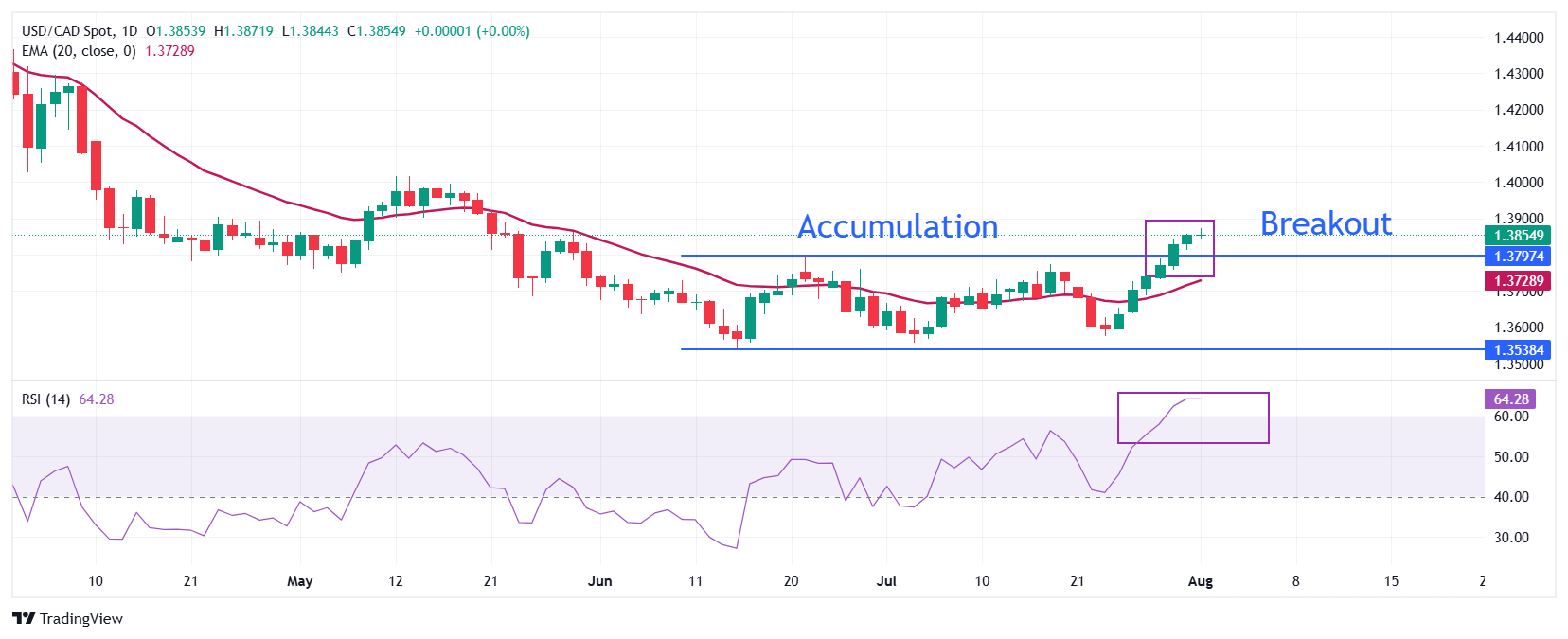Created
: 2025.08.01














![]() 2025.08.01 14:17
2025.08.01 14:17
The USD/CAD pair posts a fresh two-month high near 1.3870 on Friday. The Loonie pair strengthens as an increase in the tariff rate announced by United States (US) President Donald Trump on imports from Canada has weakened the Canadian Dollar (CAD).
On Thursday, US President Trump unveiled a list, dictating tariff rates for nations that have failed to reach a deal with Washington during the deadline period. Trump imposed 35% additional duty on imports from Canada, which are higher than 25% stated in the mid of July.
In response, Canadian Prime Minister Mark Carney has said during the late Asian session that the government is disappointed with the US on the fresh tariff rate, while confirming that negotiations with Washington are still going on.
Meanwhile, the US Dollar (USD) trades firmly as traders have pared Federal Reserve's (Fed) interest rate cut bets for the September policy meeting.
In Friday's session, investors will focus on the US Nonfarm Payrolls (NFP) data for July, which will be published at 12:30 GMT.
USD/CAD strengthens after a breakout of the Accumulation phase formed in a range between 1.3540 and 1.3800 in past seven weeks, which often leads to a strong bullish trend.
Upward-sloping 20-day Exponential Moving Average (EMA) near 1.3730 suggests that the near-term trend is bullish.
The 14-day Relative Strength Index (RSI) shifts inside the 60.00-80.00 range, indicating a strong bullish momentum.
Going forward, an upside move by the pair above the May 21 high of 1.3920 would open the door towards the May 15 high of 1.4000, followed by the April 9 low of 1.4075.
On the contrary, the asset could slide towards the psychological level of 1.3500 and the September 25 low of 1.3420 if it breaks below the June 16 low of 1.3540.

Tariffs are customs duties levied on certain merchandise imports or a category of products. Tariffs are designed to help local producers and manufacturers be more competitive in the market by providing a price advantage over similar goods that can be imported. Tariffs are widely used as tools of protectionism, along with trade barriers and import quotas.
Although tariffs and taxes both generate government revenue to fund public goods and services, they have several distinctions. Tariffs are prepaid at the port of entry, while taxes are paid at the time of purchase. Taxes are imposed on individual taxpayers and businesses, while tariffs are paid by importers.
There are two schools of thought among economists regarding the usage of tariffs. While some argue that tariffs are necessary to protect domestic industries and address trade imbalances, others see them as a harmful tool that could potentially drive prices higher over the long term and lead to a damaging trade war by encouraging tit-for-tat tariffs.
During the run-up to the presidential election in November 2024, Donald Trump made it clear that he intends to use tariffs to support the US economy and American producers. In 2024, Mexico, China and Canada accounted for 42% of total US imports. In this period, Mexico stood out as the top exporter with $466.6 billion, according to the US Census Bureau. Hence, Trump wants to focus on these three nations when imposing tariffs. He also plans to use the revenue generated through tariffs to lower personal income taxes.
![]()
Created
: 2025.08.01
![]()
Last updated
: 2025.08.01

FXStreet is a forex information website, delivering market analysis and news articles 24/7.
It features a number of articles contributed by well-known analysts, in addition to the ones by its editorial team.
Founded in 2000 by Francesc Riverola, a Spanish economist, it has grown to become a world-renowned information website.
We hope you find this article useful. Any comments or suggestions will be greatly appreciated.
We are also looking for writers with extensive experience in forex and crypto to join us.
please contact us at [email protected].
Disclaimer:
All information and content provided on this website is provided for informational purposes only and is not intended to solicit any investment. Although all efforts are made in order to ensure that the information is correct, no guarantee is provided for the accuracy of any content on this website. Any decision made shall be the responsibility of the investor and Myforex does not take any responsibility whatsoever regarding the use of any information provided herein.
The content provided on this website belongs to Myforex and, where stated, the relevant licensors. All rights are reserved by Myforex and the relevant licensors, and no content of this website, whether in full or in part, shall be copied or displayed elsewhere without the explicit written permission of the relevant copyright holder. If you wish to use any part of the content provided on this website, please ensure that you contact Myforex.
Myforex uses cookies to improve the convenience and functionality of this website. This website may include cookies not only by us but also by third parties (advertisers, log analysts, etc.) for the purpose of tracking the activities of users. Cookie policy